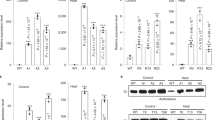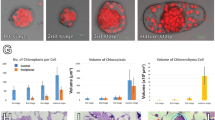Abstract
THE fact that some chloroplast mutations are inherited in a non-Mendelian fashion indicates that chloroplasts possess a degree of genetic autonomy1. Treatment of Euglena gracilis with any one of a variety of chemical or physical agents leads to the permanent loss of chloroplasts and results in permanently ‘bleached’ but viable cells2. While the chemical nature of the hereditary units of chloroplasts remains uncertain, Schiff et al. and Gibor and Granick have concluded from work on the ultra-violet inactivation of the Euglena chloroplast-forming system that cytoplasmic or chloroplast nucleoprotein is involved3. The action spectrum for the photoreactivation of the chloroplast-forming system is similar to that found for systems in which thymine dimer formation has been shown to be the primary result of ultra-violet irradiation4. The report that the ultra-violet resistance of the Euglena chloroplast-forming system is increased in cells which have been grown in the presence of 6-azathymine also suggests that DNA is the ‘target’ in ultra-violet inactivation5. Chemical and histochemical experiments to detect DNA in the chloroplasts of various organisms have led to conflicting views6. Two reports of the incorporation of tritiated thymine into chloroplasts7 provide further evidence for the involvement of DNA in chloroplast heredity.
This is a preview of subscription content, access via your institution
Access options
Subscribe to this journal
Receive 51 print issues and online access
$199.00 per year
only $3.90 per issue
Buy this article
- Purchase on Springer Link
- Instant access to full article PDF
Prices may be subject to local taxes which are calculated during checkout
Similar content being viewed by others
References
Granick, S., in The Cell, edit. by Brachet, J., and Mirsky, A. E., 2 (Academic Press, New York, 1960).
Smillie, R. M., Canad. J. Bot., 41, 123 (1963).
Schiff, J. A., Lyman, H., and Epstein, H. T., Biochim. Biophys. Acta, 51, 340 (1961). Gibor, A., and Granick, S., J. Cell Biol., 15, 599 (1962).
Wulff, D. L., and Rupert, C. S., Biochem. Biophys. Res. Comm., 7, 237 (1962).
Lyman, H., and Smillie, R. M., Abst. Amer. Soc. Biol. Meetings, San Francisco (1962). Wacker, A., and Jacherts, D., J. Mol. Biol., 4, 413 (1962).
Ris, H., and Plant, W., J. Cell Biol., 13, 383 (1962).
Stocking, C. R., and Gifford, E. M., Biochem. Biophys. Res. Comm., 1, 159 (1959). Scher, S., and Sagen, L., Science News Letter, 81, 35 (1962) (quoted by Smillie, R. M. (ref. 2)).
Epstein, H. T., and Schiff, J. A., J. Protozool., 8, 427 (1961).
Brawerman, G., and Chargaff, E., Biochim. Biophys. Acta, 31, 164 (1959).
Reich, E., Franklin, R. M., Shatkin, A. J., and Tatum, E. L., Proc. U.S. Nat. Acad. Sci., 48, 1238 (1962).
McCalla, D. R., J. Protozool. (in the press).
Haemmerling, J., Ann. Rev. Plant Physiol., 14, 65 (1963).
Author information
Authors and Affiliations
Rights and permissions
About this article
Cite this article
MCCALLA, D., ALLAN, R. Effect of Actinomycin D on Euglena Chloroplast Formation. Nature 201, 504–505 (1964). https://doi.org/10.1038/201504a0
Issue Date:
DOI: https://doi.org/10.1038/201504a0
This article is cited by
-
Einflu� von R�ntgenstrahlen und Hemmstoffen der Proteinsynthese auf die Synthese von Chlorophyll und NADP-abh�ngiger Glycerinaldehyd-3-Phosphat-Dehydrogenase in ergr�nender Euglena gracilis
Archiv f�r Mikrobiologie (1973)
-
Die Wirkung von RNA- und Proteinsyntheseinhibitoren auf den Chlorophyllgehalt kernhaltiger und kernloser Acetabularien
Planta (1969)
-
Die Wirkung von Phytochrom und Actinomycin D auf die Chlorophyll a-Synthese von Senfkeimlingen (Sinapis alba L.)
Planta (1966)
-
Untersuchungen zur Regulation der Bacteriochlorophyll-Synthese bei Rhodospirillum rubrum
Archiv f�r Mikrobiologie (1965)
Comments
By submitting a comment you agree to abide by our Terms and Community Guidelines. If you find something abusive or that does not comply with our terms or guidelines please flag it as inappropriate.



